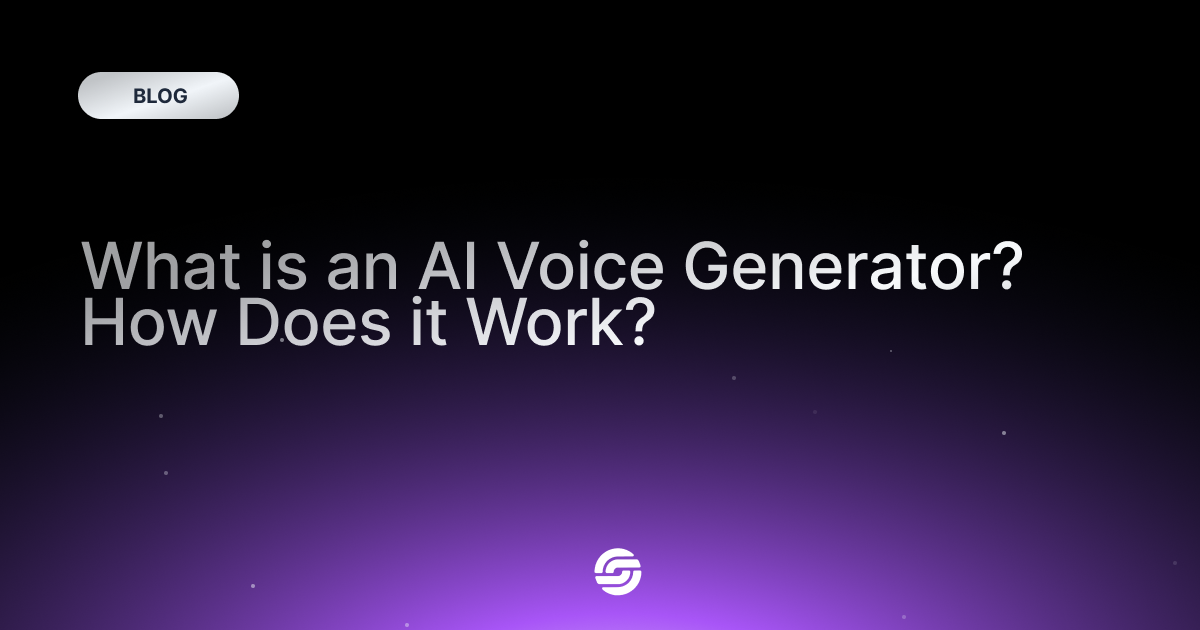What is an AI Voice Generator? How Does it Work?

AI Voice generators are a hot topic in today's tech world. These tools turn written text into spoken words, making speech sound lifelike and natural. You've probably heard them in navigation apps, digital assistants, or audiobooks. They use advanced algorithms and AI to create human-like speech, making it easier for humans and machines to communicate.
What is an AI Voice Generator?
A voice generator, also called a voice synthesizer, is a system that creates artificial spoken language. These devices or apps turn text into speech, making a voice that sounds like a human. They are important in fields like customer service, entertainment, education, and assistive technology, where they help improve access and efficiency.
Using advanced tech like text-to-speech (TTS) and artificial intelligence, voice generators produce clear and timely spoken outputs. Over time, they've evolved from simple robotic voices to more expressive and natural-sounding ones, finding use in virtual assistants, audiobooks, content creation, and more.
How Voice Generators Work
Basics of Voice Synthesis
Voice synthesis is all about creating human-like speech sounds. It's the base for voice generators, aiming to mimic the nuances of human speech. There are a few main methods used:
- Concatenative Synthesis: This method stitches together small recorded segments of speech, like putting together a puzzle. The quality can be high, but it's limited to the pre-recorded samples.
- Formant Synthesis: Instead of using recorded snippets, this method digitally simulates the human vocal tract. It can sound mechanical but offers great flexibility.
- Parametric Speech Synthesis: Techniques like HMM-based synthesis use statistical models to produce natural sounds and different speaker styles. It doesn’t need as much recorded data as concatenative synthesis.
You can integrate Each AI's Voice Generator with other AI models like ChatGPT and Luma in your workflow engine, enabling seamless multi-model workflows for tasks involving speech, text, and visuals.
Text-to-Speech (TTS) Technology
Text-to-speech (TTS) technology is a prevalent application within voice generation. TTS systems are designed to convert written text into spoken words efficiently.
1. Text Analysis and Pre-processing: The system breaks the text into phonetic parts, checking syntax, punctuation, and formatting to ensure correct pronunciation of words, including tricky ones like abbreviations and numbers.
2. Phonetic Conversion: Words are then converted into phonetic transcriptions, translating text into sounds that mimic spoken language.
3. Prosody Generation: Prosody, which includes rhythm, stress, and intonation, is generated to make the speech sound natural and expressive.
4. Audio Signal Processing: Finally, the system converts the phonetic transcription and prosody into an audio signal, producing the synthesized speech.
Recent advances in artificial intelligence have greatly improved TTS technology, making it more accurate and natural-sounding.
Applications of Voice Generators
Voice generators are now crucial in many areas due to progress in AI voice technology and voice synthesis. Let's look at some key uses of voice generators that are changing our interaction with technology.
Virtual Assistants
Virtual assistants, such as Amazon's Alexa, Apple's Siri, and Google Assistant, rely heavily on voice generators to communicate with users. These systems are designed to understand and respond to voice commands in real-time. Here's how voice generators play a role in virtual assistants:
- Natural Interaction: Voice generators enable virtual assistants to respond in a natural-sounding human voice, which enhances user experience. This makes interactions feel more like a conversation with an actual person, rather than a robotic exchange.
- Language Flexibility: Virtual assistants use voice synthesis to support multiple languages and dialects, broadening their accessibility and usability across different regions and cultures.
- Continuous Learning: These systems can improve over time by learning from past interactions, allowing voice generators to become more accurate in pronunciation and context recognition.
Customer Service Bots
Customer service efficiency has been greatly enhanced by the implementation of voice generators in customer service bots. These are programmed to handle a wide array of inquiries and support requests, leveraging voice synthesis for interaction. Here’s how voice generators contribute to customer service:
- 24/7 Availability: Unlike human representatives, customer service bots enabled with voice technology can provide around-the-clock support, significantly reducing wait times and improving customer satisfaction.
- Scalable Solutions: Businesses can handle large volumes of customer interactions simultaneously without the need for additional human resources, thanks to the versatility of AI-driven voice generators.
- Consistent Messaging: Voice generators ensure that information delivered by customer service bots remains consistent and up-to-date, diminishing the risk of human error in responses and ensuring a reliable customer experience.
Conclusion
To sum up, voice generators have changed how we use technology by turning text into natural-sounding speech. They use advanced AI called text-to-speech (TTS) systems to mimic human voices. From virtual assistants and helping the visually impaired to new creative uses, voice generators are a key innovation. With ongoing tech advancements, these tools will become even more important in our daily lives.
